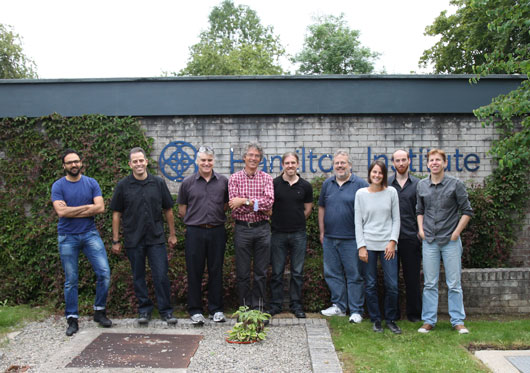All blood cells, red and white, originate from Hematopoietic Stem Cells (HSCs), which reside in the bone marrow. Before becoming a white blood cell or red blood cell (erythrocyte), a series of maturation steps takes place, in which offspring of HSCs progressively develop into the final blood cell lineages. That is, the cells increasingly commit to produce only restricted classes of cell types. Until now, the first step in this branching process was thought to involve the split of daughters of hematopoietic stem cells into two types of precursor cells: one that has the capacity to yield lymphoid cells (e.g. T and B lymphocytes, NK cells), and another that has the capacity to yield both erythrocytes and myeloid cells (monocytes, macrophages, etc). Recent research shows that this differentiation process is much more complicated, with hematopoietic stem cells branching into four to five precursor cell types.

Photo: HFSP Research Grant holders Ken Duffy and Ton Schumacher and collaborators. From left to right: Shalin Naik (WEHI), Andrew Cohen (Drexel University), Phil Hodgkin (WEHI), Rob de Boer (Utrecht University), Ken Duffy (Hamilton Institute), Walter Mankowski (Drexel University), Leïla Perié (Curie Institute), Tom Weber (Hamilton Institute), Ton Schumacher (NKI)
This discovery was made using a technology called cellular barcoding that was developed by the Schumacher lab that forms part of this HFSP team, and that allows one to identify the offspring of individual cells in vivo. In collaboration with theoreticians Prof Ken Duffy from the Hamiton Institute in Ireland and Prof Rob de Boer from Utrecht University, Dr Leïla Perié, at that time a postdoctoral fellow in the Schumacher lab, exploited cellular barcoding to study the commitment into red blood cells and myeloid cells, and showed that the earlier model needs to be revised.
This work, part of the HFSP funded research project to dissect hematopoiesis at the single cell level, will help to understand how to reboot the blood system, for example, during bone marrow transplant after chemotherapy.
Text by Leïla Perié (Curie Institute) and Ton Schumacher (The Netherlands Cancer Institute)
Reference
The Branching Point in Erythro-Myeloid Differentiation. Perié L, Duffy KR, Kok L, de Boer RJ, Schumacher TN. Cell. 2015 Dec 17;163(7):1655-62. doi: 10.1016/j.cell.2015.11.059.


































